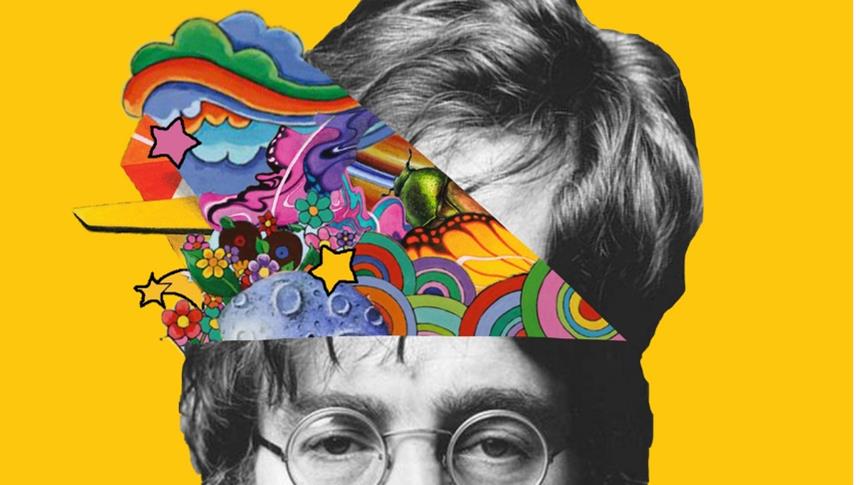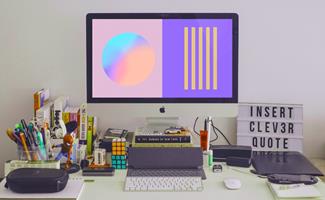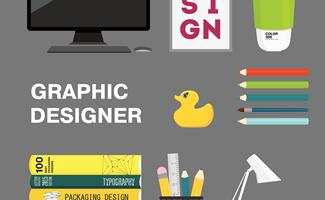Student Work: Lydia Easun, BA (Hons) Graphic Design
Graphic design is everywhere, from the creatives you see on social media and the billboards outside your house to the flyers and brochures you receive in the post. But what is graphic design all about? Read on to find out more about it, its elements and the principles involved in it.
What is graphic design?
Graphic design can be defined as the process used to create textual and visual content in order to communicate a particular message. It includes magazine design, packaging design, advertising design, brochure and logo graphic design and computer graphic design. Graphic design consists of certain key elements, such as:
- Lines: Lines may seem a basic design element, but there are extremely important when it comes to graphic design. From thin, thick and curved to straight, solid and not solid, lines come in many different forms and they are an important starting point for design. They can be used to guide users from one element to another, focus the users’ view on a particular element, differentiate sections in a design or connect two or more points.
- Shapes: The basic geometric shapes used in graphic design are triangles, squares, circles and rectangles. These are used for decorative purposes or to focus the users’ attention on a specific element. Shapes can also have different meanings, for example, squares tend to give an image a more tidy impression, while ovals have a welcoming effect on people.
- Colour: Colour in graphic design is used to interpret emotion and attract users’ attention. For example, yellow represents optimism and happiness, green signifies nature and wealth, blue represents professionalism and peace and red denotes passion, strength or anger.
- Texture: It is possible to create visual texture with the assistance of certain graphic design techniques. Texture is added to provide a background to web designs, attract the users’ attention to an element in the design or improve the overall visual attractiveness of a design.
- Size: Usually, the size of an element in a design denotes its importance. If the size of an element is large, it means that the element is very important in the graphic design. This is because a large image draws the users’ attention first.
Principles of graphic design:
- Alignment: Alignment in graphic design can be defined as arranging the elements in a design along the centre, bottom, top or the sides of the design space. The elements do not necessarily have to be the same size and this process is only carried out with the aim of creating a crisp appearance in the design.
- Proximity: Proximity also assists in organising a design by grouping similar elements together, essentially placing them in relation to each other. This principle does not mean that similar elements need to be clustered together however, they could also be visually connected using visual aids like font, colour, size or type.
- Balance: Balance adds stability and form to a design. It also does not necessarily mean that the elements must be distributed evenly or must be of the same size as balance can be either symmetrical or asymmetrical. All sides of a page layout have the same shape, lines and elements in symmetrical balance. On the other hand, asymmetrical balance has similar elements on different sides of the page layout.
- Hierarchy: Hierarchy in graphic design refers to giving extra weight to the element that has the most importance in a message. This can be implemented by using bolder or larger fonts, using shapes to surround the important element or placing this element at the top of the design. The first step in incorporating this principle is to determine the goals of the design and determining which elements are important for getting your message across.
- Repetition: Repetition in graphic design helps in improving the overall look of the design by tying different elements together, which also helps in adding consistency and organisation. Repetition in a design could consist of a succession of bullet points that have the same colour, size and type.
- Space: The part in a design that is left empty is referred to as ‘space’ and it is considered to be equally important as the part of the design that includes images, text and colours. There are two types of space in graphic design — passive and negative. Passive space refers to the margins that exist between the various elements in a design. On the other hand, the space that is intentionally left in a design is known as negative space. Negative space in a design helps to divert the users’ attention to the elements in a design.
Graphic design tips for beginners:
- Gather inspiration;
- Focus on alignment;
- Choose the correct fonts;
- Opt for colours that complement each other;
- Ensure that the quality of images chosen remains consistent across the design;
- Create crisp, readable and attractive designs;
- Keep the hierarchy principle in mind while creating designs.
Graphic design software for beginners:
- Adobe Photoshop;
- Adobe Illustrator;
- Adobe InDesign;
- Inkscape;
- Clip Studio;
- GIMP;
- CorelDraw.
If you have an eye for visual details and are interested in communicating and interacting with people, you should check out the graphic design courses offered by London College of Contemporary Arts (LCCA). The graphic design programmes offered by LCCA include HNC/HND in Graphic Design, BA (Hons) Graphic Design and CPD Graphic Design.
If you are interested in learning more about graphic design, read How to Get a Graphic Designer Job After Graduation for more information on this exciting and ever-expanding field.


 Top 5 graphic design trends for 2021
Top 5 graphic design trends for 2021  5 Web-based design tools you can use to explore your creativity!
5 Web-based design tools you can use to explore your creativity!  Top 10 Graphic Design Resources to Check Out
Top 10 Graphic Design Resources to Check Out  7 ways to improve your creativity as a graphic designer
7 ways to improve your creativity as a graphic designer  How is Visual Communication Different from Graphic Design?
How is Visual Communication Different from Graphic Design?